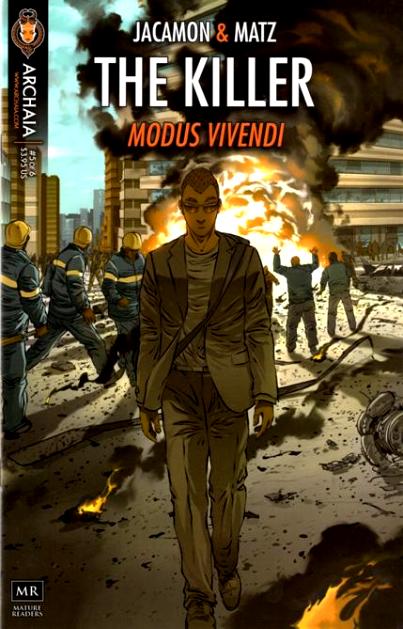The Killer: Modus Vivendi 5
Reviewed by Peter Campbell 09-Dec-10
An acclaimed series, taken from an award-winning series of European albums featuring the exploits of an introspective hitman, carrying out assassinations for political factions whose purposes he only slowly begins to understand. What could be better?
I was really looking forward to reading this. An acclaimed series, taken from an award-winning series of European albums featuring the exploits of an introspective hitman, carrying out assassinations for political factions whose purposes he only slowly begins to understand. What could be better?
In actuality, it’s something of a disappointment. It begins with a spectacular assassination, and events flip backwards and forwards in time, showing the events leading up to that episode, and its repercussions. It begins well, but it goes rapidly downhill.
The main blame here must lie with writer Matz. Subtlety is not his strong point. There’s clunky, somewhat preachy inner monologues, combined with expository dialogue. There’s long ruminations on man’s savagery. Background information is provided in huge, unwieldy chunks when the lead character tunes into the radio. If ever there was a case for show and not tell, then this is it.
Take the opening scene, for example. It packs a punch, but this is in spite of, not because of, the character’s analysis of the event. Here’s how it goes: Preparation for the assassination, with introspective commentary. Shoot. Messy killing. Introspective monologue. Shoot. Messy killing. Introspective monologue. It reminded me of the long-winded and largely unnecessary thought-balloons you’d get during one of Chris Claremont’s convoluted X-Men sagas. Quite apart from being thoroughly unrealistic (the analysis would surely come after the event, not during it), it slows the narrative down horribly. You can see what he’s aiming for: existentialist noir, but his skill doesn’t match his ambition. By the end of the issue, I found myself skimming over the text, so uninteresting had it become.
The art, by Jacamon, is much better. It’s of a type, and the type is the clear-line, Herge-influenced art you’ll find throughout Europe. It’s cool, and often finely-executed, with a grasp of dynamics and perspective that you seldom find in comics’ US counterparts. There’s undoubted skill on offer, though it occasionally comes a cropper when it attempts a more adventurous layout (most evident during a scene involving a helicopter crash – the helicopter blades become the panel’s dividing lines and your eye becomes confused by the dynamic of the scene). At the same time, there’s nothing particularly distinctive about it. Pick up any European album, and you’ll find examples of art that’s equally fine and often more individual. That doesn’t make it bad, but it’s less impressive when placed in context.
So: a mediocre storyline coupled with fine but rather generic art. It pains me to write this review, because I’d love to see more European work available in translation, but this struck me as a heavy-handed and massively overrated comic. Full points for ambition, and considerably less for execution.
Tags: Archaia, European, Luc Jacamon, Matz